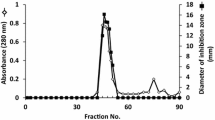Abstract
The current work was attempted to isolate and characterize the serratiopeptidase producing Serratia sp. Among the 10 bacterial isolates 7 strains were identified as Serratia sp. Out of 7 strains one showed potent proteolytic activity and selected for further studies. Based on the morphological, biochemical and molecular characterization, the potent isolate (RH03) was identified as Serratia marcescens (GenBank accession number: KC961637) and the strain was designated as Serratia marcescens VITSD2. The production of serratiopeptidase was carried out in trypticase soya broth and the enzyme was partially purified using ammonium sulfate precipitation and dialysis. The specific activity was determined by casein hydrolysis assay and was found to be 12.00, 21.33, and 25.40 units/mg for crude, precipitated and dialysed samples. The molecular weight of the protease was determined by SDS-PAGE and it was found to be 50 kDa. The antibacterial activity of the produced serratiopeptidase showed moderate activity against Pseudomonas aeruginosa MTCC No. 4676 (12 mm) and Escherichia coli MTCC No. 1588 (15 mm).
Similar content being viewed by others
References
Aiyappa P S, Harris J O (1976). The extracellular metalloprotease of Serratia marcescens: I. Purification and characterization. Mol Cell Biochem, 13(2): 95–100
Altschul S F, Gish W, Miller W, Myers E W, Lipman D J (1990). Basic local alignment search tool. J Mol Biol, 215(3): 403–410
Chenna R, Sugawara H, Koike T, Lopez R, Gibson T J, Higgins D G, Thompson J D (2003). Multiple sequence alignment with the Clustal series of programs. Nucleic Acids Res, 31(13): 3497–3500
Decedue C J, Broussard E A N 2nd, Larson A D, Braymer H D (1979). Purification and characterization of the extracellular proteinase of Serratia marcescens. Biochim Biophys Acta, 569(2): 293–301
Ding Y, Lawrence C E (2003). A statistical sampling algorithm for RNA secondary structure prediction. Nucleic Acids Res, 31(24): 7280–7301
Felsenstein J (1985). Confidence limits on phylogenies: An approach using the bootstrap. Evolution, 39(4): 783–791
Grimont P A D, Grimont F, Dulong de Rosnay H L C (1977). Characterization of Serratia marcescens, S. liquefaciens, S. plymuthica and S. marinoruba by electrophoresis of their proteinases. J Gen Microbiol, 99(2): 301–310
Gruber A R, Lorenz R, Bernhart S H, Neuböck R, Hofacker I L (2008). The Vienna RNA websuite. Nucleic Acids Res, 36(Web Server issue): W70–74.
Mohankumar A, Raj R H K, (2011). Production and characterization of Serratiopeptidase enzyme from Serratia marcescens. Int J Biol, 3(3)
Holt J G (1994). Group 17 Gram-Positive Cocci: Bergey’s Manual of Determinative Bacteriology, ed 9th. Baltimore: William & Wilkins: 529–541
Lowry O H, Rosebrough N J, Farr A L, Randall R J (1951). Protein measurement with the Folin phenol reagent. J Biol Chem, 193(1): 265–275
Machielsen R, Uria A R, Kengen S W M, van der Oost J (2006). Production and characterization of a thermostable alcohol dehydrogenase that belongs to the aldo-keto reductase superfamily. Appl Environ Microbiol, 72(1): 233–238
McCaskill J S (1990). The equilibrium partition function and base pair binding probabilities for RNA secondary structure. Biopolymers, 29(6–7): 1105–1119
Miguel F, Carrascosa José R (2013). Serratia marcescens rhabdomyolysis. Adv Inf Diseases, 3(02): 63–64
Miyata K, Maejima K, Tomoda K, Isono M (1970). Serratia protease. Part I.Purification and general properties of the enzyme. Agric Biol Chem, 34(2): 310–318
Nakahama K, Yoshimura K, Marumoto R, Kikuchi M, Lee I S, Hase T, Matsubara H (1986). Cloning and sequencing of Serratia protease gene. Nucleic Acids Res, 14(14): 5843–5855
Nirale N M, Menon M D (2010). Topical formulations of serratiopeptidase: development and pharmacodynamic evaluation. Indian J Pharm Sci, 72(1): 65–71
Saitou N, Nei M (1987). The neighbor-joining method: a new method for reconstructing phylogenetic trees. Mol Biol Evol, 4(4): 406–425
Subbaiya R, Ayyappadasan G, Mythili S V, Dhivya E, Ponmurugan P (2011). Pilot scale microbial production and optimization of Serratia peptidase from Serratia marcescens. J Ecobiotechnol, 3(12): 10–13
Trumbore MW, Rariy RV, Hirsh M, Hirsh J, Saunders JA (2005). Composition for topical enzymatic debridement. Collegium Pharmaceuticals, Inc, USPT application no. 20050281806-A1
Valeria M D, Borin M F, Fonseca M J (2003). Topical formulation with superoxide dismutase: Influence of formulation composition on physical stability and enzymatic activity. J Pharm Biomed Anal, 3(32): 97–105
Weissmann G (2006). Homeopathy: Holmes, Hogwarts, and the Prince of Wales. FASEB J, 20(11): 1755–1758
Yourassowsky E, van der Linden M P, Lismont M J, Crokaert F (1989). Growth curve patterns of Escherichia coli, Serratia marcescens, and Proteus vulgaris submitted to different tigemonam concentrations. J Chemother, 1(Suppl 2): 49–53
Zuker M, Stiegler P (1981). Optimal computer folding of large RNA sequences using thermodynamics and auxiliary information. Nucleic Acids Res, 9(1): 133–148
Author information
Authors and Affiliations
Corresponding author
Rights and permissions
About this article
Cite this article
Devi, C.S., Elizabeth Joseph, R., Saravanan, H. et al. Screening and molecular characterization of Serratia marcescens VITSD2: A strain producing optimum serratiopeptidase. Front. Biol. 8, 632–639 (2013). https://doi.org/10.1007/s11515-013-1284-9
Received:
Accepted:
Published:
Issue Date:
DOI: https://doi.org/10.1007/s11515-013-1284-9




